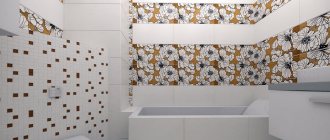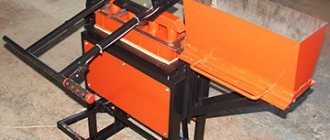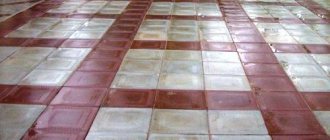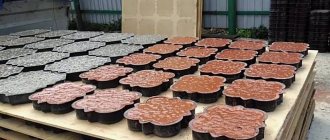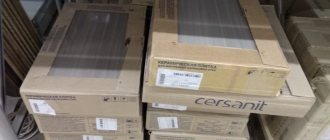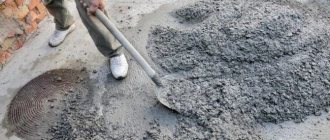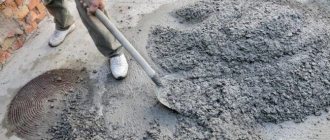Polymer sand tiles are called eternal. She earned this epithet due to her highest performance characteristics. The material is based on a filler – quartz sand, and a binder – polymer. These tiles are replacing cement tiles and are conquering the market at a tremendous pace. Its advantages are lightness, abrasion resistance, durability and variety of shapes.
Brief analysis of the business: Costs of organizing a business: 1.6 – 1.9 million rubles Relevant for cities with a population: from 50 thousand Situation in the industry: the production sector is not developed Difficulty of organizing a business: 3/5 Payback period: 9-15 months
What are polymer-based tiles?
Polymer sand tiles are named so for their composition. The bulk and 3/4 of the volume is occupied by ordinary purified quartz sand - an environmentally friendly and very cheap material. The other 25% of the tile composition is a binder - LDPE (high-density polyethylene) granules. In addition to it, impurities of other petroleum products get into the tiles, but their quantity is insignificant.
Polymer-based tiles can be used in the most severe conditions. It is durable and works well against compression, and therefore against abrasion. This gives it a head start over cement tiles, which after five years begin to crumble, its corners and cuts are gradually destroyed.
You may be interested in similar ideas:
- production of paving slabs
- paving stone production
The polymer in the tile makes it plastic, which protects the product from phenomena such as cracking in the cold. The main reason why road surfaces, building plinths and cement-based tiles are destroyed is repeated freezing and thawing. Water enters microcracks in the material, freezes, expands and breaks the stone.
After thawing, moisture penetrates deeper through new cracks and the situation worsens. Polymer sand tiles are made on the basis of a plastic material that does not tear, but stretches and returns to its original position, ensuring that same durability.
Application area
Due to many positive features, laying polymer-sand tiles is very popular.
Today it is used in organizing:
- Adjacent areas - elegant garden paths, platforms and gazebos are created using paving stones.
- Landscape design - decorative tiles “fit” correctly into the design of the site and are combined with plants.
- Road surfaces at gas stations or service stations.
- Trading halls.
- Playgrounds on summer terraces.
The tiles can be sold in the form of tiles, which allows them to be used for roofing. Facing products for finishing work are also available on the market.
Product advantages
Polymer sand tiles have a rich set of positive characteristics that determine the scope of their application. This material is characterized by the following features:
- compressive and bending strength;
- abrasion occurs extremely slowly; it has been experimentally established that the lifespan of such tiles when laid in a pedestrian area is 30 years;
- the material is chemically neutral, so it can be used in aggressive environments;
- the tiles have a rough surface, which is convenient in winter in areas in front of shops and public buildings;
- polymer-sand paving slabs are easy to install, as they are larger in size compared to traditional cement tiles;
- rich color range and choice of textures.
Production technology
The polymer that makes up the tile is chemically neutral; it can only be dissolved with nitric acid, and then only under certain conditions. In order for it to form a homogeneous mixture with sand and pigment, it must be melted. This happens at a temperature of 180 degrees and atmospheric pressure, this process is called extrusion.
Preparation of raw materials
Polymer sand tiles are made from quartz sand, polymer and pigments. Sand must meet technological requirements: have a moisture content of no more than 10% and be free of foreign inclusions. Sand preparation involves sifting and drying.
Polymer is PVD granules or polyethylene in any other form. When using recycled materials, the plastic must be literally crushed into dust in order to be able to mix the components evenly. Pigment is an integral element of the composition that gives the tile its decorative properties. The pigments most often used in tile production are:
- iron oxides to produce orange, red and brown colors;
- chromium oxide – green pigment;
- Titanium dioxide is a white dye.
Mixing and melting
After the components are prepared, they are sent to a concrete mixer, where a homogeneous mixture is obtained from disparate substances. This mixture is fed manually or semi-automatically into a melting apparatus - an extruder. At this stage, the polymer is melted and mixed with the main component - sand.
Molding
The mixture leaves the melting furnace in the form of a plastic mass and enters the molding section. To give the amorphous mass the appearance of a finished tile, molds and a hydraulic press are used. The higher the pressure, the faster the molding will take place.
Polymer sand paving slabs gain strength during the cooling process, which should be quite fast. To comply with the requirements of the specifications, it is necessary to provide a cooling system. After extrusion, liquid LDPE must polymerize again, turning the individual components into a monolithic stone, and the temperature regime is of decisive importance in this process.
High-quality homemade tiles: recipe, technology, secret of obtaining a marbled color
Making paving slabs at home is not only a cost saving, but also an opportunity to organize a mini-production with a profitability of more than 100%. Read the article and you will find out: how to open a home workshop for the production of tiles of unique colors, what equipment and materials are needed in production.
- Production premises and equipment
- Shapes and materials for tiles
- Technology
- Recipe for natural stone colors
Malachite colored paving slabs
The technology described below is a method for the production of artificial marble and other imitations of natural stone, suitable for the manufacture of:
- paving slabs, paving stones;
- facing tiles, panels;
- products of landscape architecture;
- eurofence;
- stairs and balusters;
- curb and drainage.
Setting up a home workshop will require minor expenses. When purchasing a complete set of equipment on the secondary market, the estimated costs will be 30,000 rubles. Do-it-yourself tiles will be half the price of purchased ones.
Balusters colors: marble, granite, malachite
Production premises and equipment
To make paving slabs at home you need:
- room from 12 m²;
- concrete mixer;
- vibrating table;
- auxiliary tool;
- forms;
- Consumables.
A garage, barn, or any building with walls and a roof is suitable as a room. It is important that the room is equipped with high-quality wiring for connecting electrical appliances. Indoors, along the walls, you need to make reliable racks for drying finished products. The recommended shelving area is 20 m².
For production you will need two main units - a concrete mixer and a vibrating table. A concrete mixer is suitable for both a forced type and a regular pear.
Typically, in home production, household concrete mixers operating on a 220 volt network are used. The recommended stirrer volume is from 180 liters.
A forced-type concrete mixer is suitable only with a low shaft speed: from 16 to 24 revolutions per minute.
Forced type concrete mixer
A vibration table will suit absolutely anyone. The main function of the vibrating table is to shake the solution in the mold. Its cost on the secondary market starts from 5,000 rubles. If you have welding equipment, you can make a vibrating table yourself. To do this, you need a corner or pipe, a sheet of metal, springs, and an electric motor.
Electric motors can be used both specialized ones, which are made for vibration equipment, and household ones, used for sharpening knives. The main thing is that the engine speed is from 1800 to 3000 per minute.
Vibrating table
The following auxiliary equipment will be needed: shovels, trowels, buckets, a trough, a container for water and plasticizer, large and small scales, a hair dryer. To dry the tiles, you will need a cellophane film with an area of 6 - 10 m².
Shapes and materials for tiles
The tiles are cast into plastic molds, which can be purchased both used and new. The cost of new forms starts from 400 rubles per sq. m. meter. Used molds can be purchased at a price of 70 rubles per 1 m². To produce paving slabs with your own hands, it is enough to buy 20 molds.
PVC tile molds
When purchasing molds, you need to know that the most practical molds are PVC products. They can withstand up to 150 castings. You can also use ABS plastic molds. They provide a smoother surface, but their lifespan is limited to 50–70 applications.
When purchasing molds, you need to consider where the tiles will lie. If it is laid as a garden path, then a thickness of 30 or 50 mm is suitable. If the tiles will be laid in front of the garage, then it is worth buying molds for tiles with a thickness of at least 70 mm.
ABS plastic mold
To make tiles you will need:
- construction sand;
- crushed stone fraction 5–20;
- cement M400 or M500;
- plasticizer for concrete;
- iron oxide dye (white, red, green, yellow, black).
All these materials are available for free sale.
Crushed stone fraction 5 – 20
Technology, from solution to drying
Artificial marble or stone is a big name. In fact, two concrete solutions painted in different colors are simply mixed and poured into a mold. A bizarre pattern reminiscent of a cut of natural stone is obtained under the influence of vibration.
Production begins with mixing the concrete mixture. Components are placed in the concrete mixer based on:
- 1 part cement;
- 2 parts sand;
- 1.5 parts crushed stone.
The components need to be weighed and proportions based on weight, not volume. All components are mixed in a concrete mixer without adding water for 10 minutes. After stirring the mixture dry, you need to take 10% of the total mass into a separate container.
Mixing the solution
Next, white dye (titanium dioxide) is poured into the concrete mixer and the solution is mixed dry for another 5-7 minutes. White color is added at the rate of 3% of the total mass of the mixture.
Important! White color is difficult to dye and is added in a proportion of 3% by weight of the solution. All other colors of iron oxide dyes are added at the rate of 5% by weight of cement.
Black dye is added to the container with the selected mixture at the rate of 5%, but this time by weight of cement. For example, if 50 kg are used in the general solution. cement, then the selection will be only 5 kg. 5% of 5 kilograms of cement is 250 grams. Consequently, 250 grams of black dye are added to the selection.
Bucket selection
While the white solution is mixed in a concrete mixer, the black solution should be mixed manually in a separate container. You can use a trowel for this. When the solutions are mixed, it is necessary to add mixing water.
Mixing water is prepared simultaneously with the solution. To prepare it you need a plasticizer. The required amount of water is calculated using a special coefficient, which is 0.33.
For example, if there are 50 kilograms of cement in the batch, then these kilograms must be multiplied by a factor of 0.33. 50×0.33=16.5 liters. This solution requires 16.5 liters of water. Next, you need to add a plasticizer for concrete to the water at the rate of 1% of the weight of the cement.
This batch requires 500 grams of plasticizer. The plasticizer is stirred until completely dissolved.
After preparing the water for mixing, 10% is taken from it, and the smaller part goes into a container with black paint, and the larger part goes into a concrete mixer.
If we consider the previous example, then 14.8 liters of mixing water need to be poured into the concrete mixer, and 1.65 liters into the selection. The solution with mixing water must be mixed in a concrete mixer for 15 minutes.
At the same time, you need to manually stir the black solution.
Important! The finished solution should not spread. Excess water will lead to high reject rates.
Distribution of color before mixing
After mixing the white solution into the concrete mixer, add the black solution in small portions. Next, the concrete mixer is turned on and the blades are rotated three times. This is necessary to obtain a uniformly colored solution with the structure of natural marble.
View of the mixture after mixing two colored solutions
After the solution is ready, it must be placed in molds. There is only one requirement for the forms - they must be clean and dry. Lubrication of the molds is not required, since the plasticizer prevents the solution from sticking to the walls.
Correct placement of the mortar The finished mortar is carefully placed in the molds. You need to take the solution with a trowel and, when placing it in the mold, turn it over so that the solution lies on the surface with the untouched side. This will give a beautiful color structure to the product.
Next, the forms with the solution are placed on the included vibrating table. This operation can be carried out according to the principle of a conveyor: while one form is vibrating on the table, another can be filled. When shaking the molds, the mixture will settle and you need to fill the empty volume with the solution. The main thing is not to allow vibration to affect one tile for more than 45 seconds. This may cause the colors to mix and the solution to stick to the mold.
Working on a vibrating table
Forms with finished tiles should be placed on racks or in rows on a flat area, using plywood sheets as a layer. When drying, the tiles must be covered with cellophane film and under no circumstances should they be exposed to wind or direct sunlight. Drying takes three days. In cold weather, it is recommended to extend drying to 5 days.
Drying tiles
After drying, the finished tiles should be removed from the molds. When using a plasticizer, the tiles come out without problems. If removing the tiles is difficult, you can warm up the mold with a hair dryer. The mold will expand and the tile will come out easily.
Recipe for natural stone colors
This technology allows you to imitate the colors of several types of natural stone.
Black marble is made in the same way as white marble, but only black dye is added to a large volume in a proportion of 5% by weight of cement, and white dye is added to a small volume in a proportion of 3% by weight of the solution.
Imitation of red granite is done by adding red dye to the main color and black to the additional color. The color ratio is 8 to 2. Red and black paint are added in proportions of 5% by weight of cement. When mixing colors, it is recommended to make 5 turns of the concrete mixer.
Marble color
Slate is made from a base color of yellow and an additional color of white. The proportions of the painted parts are 8 to 2. You can also make an imitation of malachite by combining the main green and additional white. The proportions of malachite are 9 to 1. The number of revolutions of the concrete mixer when mixing is 2.
Experiments with flowers
The flight of imagination is not limited here and in addition to the presented recipes, you can come up with unique color schemes consisting of two or more colors. The number of revolutions when mixing can vary from 2 to 7. A large number of revolutions will make the color stains more blurred.
On the topic - why vibropressed tiles are superior to vibrocast tiles in all respects. How to easily repair a sagging path. And also, a simple way to make decorative bricks and tiles. The video shows the technology for laying paving slabs from a specialist.
Subscribe to the channel! Share on social networks! Join FORUMHOUSE!
Equipment and premises
Production does not require complex technological lines, but you will need to invest a certain amount of money in equipment. Each of the three stages listed above requires specific machines. Below is a list of required instruments and machines in the order of their use:
- device for crushing polymer conglomerates;
- scales - for loading the required amount of raw materials;
- concrete mixer - for preparing a homogeneous mixture;
- melting furnace - to undergo the extrusion process;
- press 100 tons or 150 tons and a set of molds;
- cooling system for finished products.
In addition to the equipment on which polymer-sand paving slabs are produced, premises for production and storage will be required. Since polymer sand tiles are a heavy product, moving them will require specialized warehouse equipment - a manual or truck loader.
Upcoming expenses
In addition to the cost of equipment, you will have to carefully consider the issue of providing raw materials. A great option to reduce the cost of production is to use recycled plastic. By the way, many regions have targeted programs to encourage socially responsible businesses. The environmental component, which consists in the safe recycling of plastic and rubber waste, can become the basis for receiving various subsidies and other types of assistance.
The expenses include the following items:
- rent of premises, utility bills;
- fare;
- organization of warehousing of raw materials and finished products;
- wages (including social contributions);
- tax payments;
- Unexpected expenses.
Attachments
Any industrial production, even on a small scale, requires start-up investments. The equipment listed above is required; without it, it is simply impossible to make tiles. If you make a choice in favor of used cars, then you will have to spend at least one and a half million rubles on a complete set . The exact amount depends on the condition of the equipment, its origin, age and performance.
When buying used equipment, there is a risk of running into hidden faults that will lead to a stop in production. There are options for purchasing new production lines - financial lease or leasing . Its meaning is that the lessor company buys the necessary equipment at its own expense, puts it on its balance sheet, and leases it to the entrepreneur. A businessman carries out production using the equipment leased to him, pays lease payments on time and after some time completely buys out the production line.
Who uses tiles
Due to their high performance properties, the scope of application of tiles is extremely wide. It is gradually replacing cement tiles, artificial and natural stone, asphalt and concrete. Potential tile buyers may be:
- companies involved in laying paving slabs;
- owners of private houses who are interested in finishing the local area and exits from garages;
- owners of industrial premises, service stations, gas stations, open warehouses with overpasses;
- owners of cafes and restaurants who are interested in decorating courtyards and summer areas;
- owners of shops and public buildings who are faced with the task of finishing the adjacent territory;
- landscape designers who find tiles suitable for designing park paths.
When planning the production of polymer sand tiles, you need to understand what target client the business will be aimed at. If the visual component is important for decoration and landscape design, then for the owner of a warehouse or service station the most important criteria are price and quality. Having studied your target audience in detail, you can find a way to stand out from others at the production planning stage and thus have a clear competitive advantage.
Features of installation work
Before laying polymer-sand tiles, it is necessary to determine the possible operational load on the designed site. Depending on this, different technical requirements are imposed on the preparation of the base on top of natural soil. In particular, the following can act as a substrate:
- sand cushion.
Before filling the sand, the fertile layer of soil is removed from the ground in a layer of 200-250 mm. The bare earth becomes compacted. Along the edges of the site, trenches are formed for curbs, also with a compacted bottom. In them, the bottom is strengthened with a dense sand backfill with a layer of 30-50 mm.
Next, curb blanks are installed using cement mortar. The foundation pit itself is then covered with geotextiles with the sheets overlapping each other by 100-150 mm. The main sand cushion is formed in layers, alternating backfilling, pouring with water and compacting. The total height should be 150-200 mm. Here the slope for the natural drainage of rain and melt water must be taken into account.
You can also additionally lay a reinforcing mesh with 50*50 mm cells, cover it with a 50-70 mm layer of a mixture of sand and cement (ratio 3 to 1) and moisten it before laying polymer sand tiles using a regular garden watering can. Then you will have a private parking area for a car.
Installation of a sidewalk on a sandy base Source nipost.ru
- Sand-crushed stone mixture.
The crushed stone fraction should be 10-20 mm. Here, after installing the curb, a dense gravel backfill with sand 100-200 mm thick is formed. Such a cushion is fixed with concrete mortar, the layer of which should be 50-100 mm and create the required slope for water drainage.
- Concrete platform.
The screed is used as a base if a high operational load is expected. Here, a crushed stone layer of 150-200 mm is first compacted on top of the prepared soil, then cement mortar with grade strength M150 is poured. The thickness of the screed with a slope should be 50-100 mm.
One of the main rules for installing sidewalks is strict adherence to joints with a minimum width of 5 mm. This is due to thermal expansion of elastic products. That is, in hot summer weather, a fabric laid too tightly will be deformed even if all other technological processes are followed.
Laying tiles in compliance with the seams Source polimerplitka.ru
Marketing strategy
No matter how good and advanced the production, customers play a decisive role in achieving the success of the entire enterprise. The production of polymer sand tiles is a profitable business, but over time, competition in this area is only growing. Classic business textbooks and experienced business practitioners say that success is achieved by those who are different from others. What can make a new manufacturer stand out from dozens of similar craftsmen?
Quality is the desire to fully satisfy the needs of your client, the ability to think for him and solve his problems. In practice, this is expressed in the ability to listen to the wishes of your customer and implement the notorious individual approach. Of course, the quality of the product must be impeccable.
Commitment is the ability to respect your client’s time and know the value of your word. In practice, this means that missed deadlines are unacceptable, as well as cost increases without prior warning. The client should be treated with respect.
– the engine of sales, so participation in exhibitions and creation of samples is mandatory. It is important to collect a portfolio with photographs of completed orders and examples of the use of tiles. Here – you can find a guide to the most effective advertising.
Polymer-based tiles are a successful product, as they have already proven themselves. The entrepreneur’s task is to comply with all technological subtleties and produce a high-quality product.
